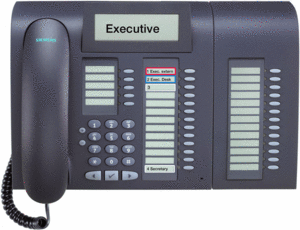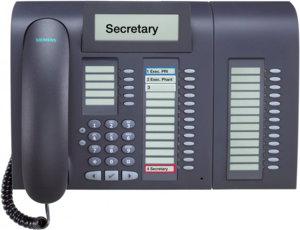Difference between revisions of "CHESE Configuration Example"
The Wiki of Unify contains information on clients and devices, communications systems and unified communications. - Unify GmbH & Co. KG is a Trademark Licensee of Siemens AG.
Hans.zeiner (talk | contribs) (→Assignment of Keys on Secretary Telephone) |
|||
| (One intermediate revision by one other user not shown) | |||
| Line 1: | Line 1: | ||
| + | <div class="breadcrumb"> | ||
| + | {{de}} [[CHESE Konfigurationsbeispiel]] | ||
| + | </div> | ||
| + | |||
== Standard Configurations == | == Standard Configurations == | ||
| Line 37: | Line 41: | ||
<br clear="all" /> | <br clear="all" /> | ||
| − | {{Info|For this solution, you need '''3''' [[ | + | {{Info|For this solution, you need '''3''' [[OpenScape Voice]] user licenses for '''2''' telephones.}} |
== Examples of Call Situations == | == Examples of Call Situations == | ||
Latest revision as of 14:31, 19 October 2009
Contents
Standard Configurations
The CHESE standard configuration is based on 2x executive and 1x secretary lines.
Possible variations:
- 2x executive / 2x secretary
- 4x executive / 1x secretary
- 4x executive / 2x secretary
It is possible to setup further configurations in the same way up to a maximum of 10 line keys per optiPoint 420 SIP terminal.
Example Configuration
Each telephone has 3 line keys, partly configured as direct call keys (DSS).
The respective LEDs show the status of the line.
- LED is flashing: a number is being dialed on the line
- LED is illuminated: a call is being made
Assignment of Keys on Executive Telephone
- Key 1 (primary line, red):
- for outgoing calls (except to secretary)
- accept incoming calls personally
- Key 2 (secondary line key, blue): accept calls from secretary
- Key 3 (DSS, white): individual assignment
- Key 4 (DSS, white): call secretary internally
Assignment of Keys on Secretary Telephone
- Key 1 (secondary line, blue):
- accept calls on the executive line
- activate/deactivate call forwarding for executive line
- Key 2 (DSS, white): call executive internally
- Key 3 (DSS, white): individual assignment
- Key 4 (Primary Line, red): accept calls in loudspeaker mode
| For this solution, you need 3 OpenScape Voice user licenses for 2 telephones. |
Examples of Call Situations
Requirements
The following CHESE examples are based on the following device mix:
- 1x executive telephone (“Executive Pri“)
- 1x secretary telephone (“Secretary“)
- 1x separate telephone
Accepting a Call for the Executive on Secretary Telephone
- Subscriber A dials the number “Executive Pri“.
- Secretary telephone rings. LED 1 flashes.
Subscriber Aappears on the Display. -
Subscriber A = = = > Executive Priappears on the display of the executive telephone. LED 1 flashes. - Subscriber A sees
Executive Prion his/her display. - Secretary presses key 1 and accepts the call.
- Subscriber A sees
Secretaryon his/her display. - Subscriber A and secretary talk. LED 1 is on.
- Secretary would like to connect to executive. Checks beforehand that LED 2 is off. If it is off, call back and presses key 2 (“Executive Pri”).
- Subscriber A hears Music on Hold.
- Executive telephone rings and LED 2 flashes.
- Executive accepts call, either by pressing key 2 or lifting receiver.
- Secretary announces subscriber A and hangs up (if executive wants to speak to him/her).
- Executive and subscriber A talk. LED 2 is illuminated on secretary telephone.
- Subscriber A sees
Executive Prion the display. - A further call for “Executive Pri“ is possible and can be accepted on the secretary telephone.
Activating/Deactivating Call Forwarding
Forwarding Calls Directly to Executive
- Secretary checks that LED 1 is not on.
- Secretary presses key 1 (“Executive Pri“ line).
- Secretary selects call forwarding to “Executive Pri“.
Forwarding Calls to Voicemail
- Secretary checks that LED 1 is not on.
- Secretary presses key 1 (“Executive Pri“ line).
- Secretary selects call forwarding to voicemail.
Instead of forwarding calls to voicemail, calls can also be forwarded to any extension, e.g. if someone is standing in. If the stand-in’s telephone should be equipped with the same functions as the “normal” secretary telephone, then a further secretary device needs to be added to the executive-secretary-group.
These line keys are then permanently configured and active on the stand-in’s telephone. In this case, it is also possible configure up to a maximum of 10 line keys per terminal.
Deactivating Call Forwarding
- Secretary presses key 1 (“Executive Pri“ line).
- Secretary deactivates call forwarding.
Executive Accepts Calls Personally
Direct Call
- Subscriber A dials “Executive Pri“ number.
- Secretary telephone rings. LED 1 flashes.
Subscriber Aappears on the display. -
Subscriber A = = = > Executive Priappears on the displays of the 2 executive telephones. LED 1 flashes. - Subscriber A sees
Executive Prion his/her display. - Executive presses key 1 (desk or corner).
- Subscriber A sees
Executive Prion his/her display. - Executive and subscriber A talk.
- LED 1 is on on secretary telephone.
- “Executive Pri“ number is engaged for further calls.
Forwarded Calls
- Subscriber A dials “Executive Pri“ number.
- Telephone on executive’s desk rings.
-
Subscriber Aappears on the display. LED 2 flashes. - Subscriber A sees
Executive Prion his/her display. - Executive presses key 2 and accepts the call.
- Subscriber A sees
Executive Prion his/her display. - Executive and subscriber A talk. LED 2 is on on secretary telephone.
- “Executive Pri“ number is engaged for further calls.
Executive Calls a Subscriber Personally
- Executive presses key 1 and calls participant C.
- LED 1 is on on secretary telephone.
- Subscriber C rings,
Executive Priappears on the display. - Subscriber C answers, executive talks with participant C.
- “Executive Pri“ number is engaged for further calls.






